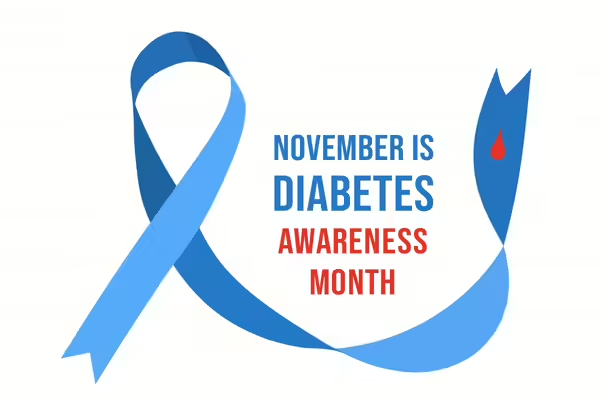
URBANA, Ill. – November is American Diabetes Month. Diabetes occurs when a person’s blood glucose, also called blood sugar, is too high. Of the 34 million people in the U.S. diagnosed with diabetes, 90% to 95% have type 2 diabetes. Prediabetes occurs when blood sugar levels are higher than normal but not high enough to be diagnosed as type 2 diabetes.
“It often takes years for type 2 diabetes to develop and is usually diagnosed in adults, but now teens and young adults are being diagnosed more often,” says Diane Reinhold, University of Illinois Extension nutrition and wellness educator. “Although researchers do not fully understand why some people develop diabetes and others do not, they know excess body weight, unhealthy food choices, and lack of physical activity are major risk factors.”
Throughout November, Illinois Extension’s team of nutrition and wellness educators are raising awareness about the risk factors associated with the development of diabetes and promoting healthy behaviors to prevent diabetes. The team developed a collection of research-based resources covering a wide variety of topics to help individuals better manage their diabetes.
Managing Diabetes in a Modern World
This recorded webinar series covers meal planning, setting realistic health goals, and talking with your healthcare provider to find resources to help manage diabetes.
- Take the First Step: Dive into what it means to have diabetes, what is going on in your body, and the next steps. Learn to set realistic personal nutrition and activity goals.
- Choose It, Count It, Eat It: Sustain, nourish, and enjoy eating while keeping on track managing diabetes. Learn about meal planning tools and counting carbohydrate servings.
- Making the Most of Your Diabetes Resources: Explore resources, services, and supports related to diabetes that you and anyone in your life can use. Learn to manage your health better with tools from websites to insurance-covered education classes and diabetes footwear.
- Fat, Sodium, and Sugar: Fat and sodium play an important role in a balanced diet, but what are they, and how much is enough? Walk away with strategies to enhance flavor while keeping sodium and sugar low.
- Managing Your Risk: Uncontrolled diabetes puts you at risk for many chronic health conditions. This session covers the importance of talking with your healthcare team, how high blood sugars impact health, and what to be aware of when you are feeling ill to help you to live a healthy life with diabetes
Additional University of Illinois Extension Resources
- Diabetes: Practicing Self-Care During Difficult Times: Managing stress during difficult times is challenging for everyone; however, if you or a loved one has diabetes, it is even more important to be intentional about managing stress.
- Recipes for Diabetes: Diabetes-friendly recipes, including main dishes, side dishes, and desserts.
- Fiesta of Flavors: Lighter alternatives to traditional Hispanic and Latin recipes allow you to enjoy your favorite dish while managing your diabetes.
Decreasing your risk of developing diabetes
If you do not have diabetes but have a family history of diabetes or are overweight, check out this simple one-minute risk screening from the American Diabetes Associations’ website. Making small changes to your everyday life and adopting a healthier lifestyle can dramatically decrease your risk of developing diabetes.
Weight loss
Losing as little as 5% to 7% of your current body weight can reduce the risk of diabetes.
“For example, a person weighing 180 pounds could improve their health by losing 9 to 13 pounds,” Reinhold says. “Which may sound more realistic than thinking you need to lose 50 pounds before you can get your health under control.”
Follow a healthy, balanced diet
A healthy, well-balanced diet can lower the risk of developing diabetes and many other chronic health conditions. The Dietary Guidelines for Americans provide evidence-based nutrition information and advice. The guides are designed to help Americans make healthy food and beverage choices.
- Your diet should include: A variety of fruits and vegetables, whole grains, low-fat dairy, lean proteins
- Limit: Saturated fat, added sugars, and sodium
Stay Active
Engaging in regular physical activity is one of the most important things people can do to improve their health and reduce the risk of developing diabetes.
“Moving more and sitting less has tremendous health benefits for everyone, regardless of age or current fitness level,” Reinhold says.
- Adults need at least 150 minutes of moderate-intensity physical activity a week
- Muscle-strengthening exercises at least two days a week
Talk to your healthcare provider
In addition to reaching a healthy weight, eating healthy, and being more active, include regular discussions with your healthcare providers.
Additional Resources
- Your Chance to Prevent Type 2 Diabetes, CDC
- The Surprising Truth About Prediabetes, CDC
- What is Diabetes? CDC
- One-Minute Type 2 Diabetes Risk Test, American Diabetes Association
- Diabetes Tests (blood sugar levels), CDC
- Dietary Guidelines for Americans 2015-2020, Office of Disease Prevention and Health Promotion
- Physical Activity Guidelines for Americans, Office of Disease Prevention and Health Promotion
The Illinois Extension Nutrition & Wellness program encourages individuals, families, and communities to live healthier through online and in-person skill sharing. Learn about managing diabetes, safely preserving foods, being food-safe at home, and making healthier choices when shopping, cooking, and meal planning. Explore their website or like their page to follow along on Facebook.
Illinois Extension leads public outreach for University of Illinois by translating research into action plans that allow Illinois families, businesses, and community leaders to solve problems, make informed decisions, and adapt to changes and opportunities.